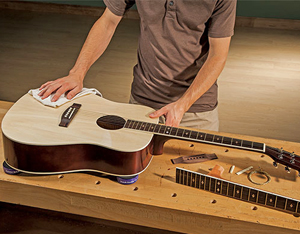
We received a follow-up from one of the questioners in a previous Q&A section, clarifying that, although he hadn’t previously mentioned this specific information, he really wanted to know about how to work with the insides of acoustic stringed instruments.
And his follow-up: “I really meant to write, ‘used on a thin piece of wood as a finish on one side.’ What I had in mind was the inside of an acoustic stringed instrument, such as an acoustic guitar. The [cyanoacrylate] would be applied and worked with before the top, (soundboard) was glued on. I’m talking about applying the cyanoacrylate to all the surfaces on the inside. I don’t know what glue luthiers normally use to glue joints and braces inside acoustic stringed instruments, but I’m pretty sure it’s not cyanoacrylate, except maybe for a minor repair.” – Roger W.
(So, essentially, what Roger wants to know is: if he uses cyanoacrylate as a finish in this manner, would the instrument pieces crack?)
Michael Dresdner: A general woodworking rule says you should finish both sides of a piece of wood the same. Otherwise, quick changes in humidity might cause the unfinished side to absorb more moisture more quickly and result in warping. While that might be a good rule for a tabletop, it is not necessary with guitars.
The inside of an acoustic guitar is typically accessible only through a relatively small (roughly 4″) sound hole. There is no cross ventilation, so irrelevant of what is going on outside the instrument, the guitar’s cavity is not prone to rapid changes in humidity. There’s simply not adequate airflow for that. To compound the issue, the guitar top is under a lot of tension (80 to over 400 pounds, depending on scale length, type, and number of strings) and is thus even less likely to warp merely from exposure to moisture. It’s not surprising, then, that most acoustic guitars are not finished on the inside.
Nevertheless, some guitar makers do finish the inside. As far as wood stability goes, interior finish may not be necessary, but it certainly will not cause wood to crack. Of course, there is wide disagreement on whether finish on the inside helps or hurts the tone of the guitar, though the fact that so few are finished inside should tell you what the majority opinion is.
If you are going to finish the inside of a guitar top with either glue or finish, you’ll usually need to do it after the braces are glued on and after the top is glued to the sides. That’s because most glues will not stick to themselves, to other glues, or to any finish. The one common exception is hide glue, which will work as a finish and as a glue, and will adhere to itself.
By way of contrast, the one glue-used-as-finish I’d definitely avoid is cyanoacrylate. It’s quite difficult to use as a finish on soft woods, like spruce, because the wood absorbs so much so quickly that it’s almost impossible to get it sealed. On thin tops cyanoacrylate can seep all the way through, resulting in ugly patches on the front, and some species will turn bright yellow when they come in contact with some formulations of cyanoacrylate.
Tim Inman: I’m a turner of little tiny things like drawer pulls and furniture ornaments. I have used CA as a finish on some of these little things, and I can tell you it is a fine finish. However, it is also a dangerous finish to apply, ask me how I know, and it probably isn’t the best choice for your intended use. My recommendation would be to encourage you to read up on “Violin Varnishes” and get/make your own fine instrument coating. It will not only be much easier and safer to use, it will give the results that have been used and tested for a long, long time. (Hint:Violin Varnishes is the title of a good book on the subject….)






